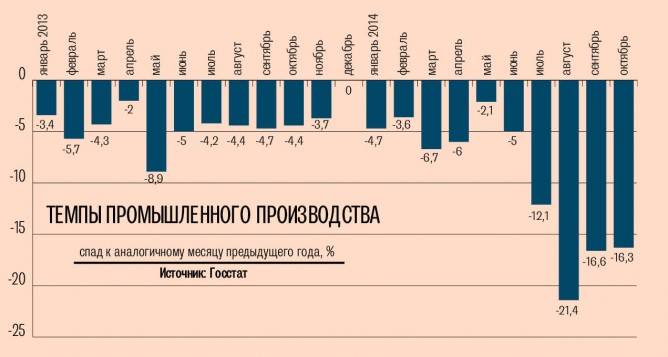Economy
macroeconomyIndustrial production at a standstill

Decline of industrial output in Ukraine has slowed down. In October 2004, industrial production fell by 16.3% compared to the same month last year, the State Statistics Service informed yesterday. Starting in May, the decline in production doubled every month up until September. After that the rate of decline of industrial output fell from 21.4% to 16.6%. Over ten months of the year, the decline in industrial output increased to 9.4%.
Alternating success
The results of October are not an indication of the revival of the industry, experts believe. The improvement of indicators last month is most likely due to the seasonal factor, says Director of the Analytical Department of Eavex Capital Dmytro Churin. At the start of the heating season in October the supply of electricity, gas and condensate increased. Statistics show that this indicator was 20% higher than in September.
The fact that only one sector managed to increase its output volumes compared to last October indicates that it is still premature to speak about improvement. The matter is about the production of food, beverages and tobacco products. Moreover, the decline in other sectors continued, first and foremost in the coal mining industry. In October of this year the extraction of coal from mines was 40% lower than last year.
As for regional indicators, it is worth noting the revival of industry in the Donbas region compared to September. However, on the whole the decrease in production in the Donetsk and Luhansk oblasts is even more catastrophic – 55.2% and 80%, respectively. As Premier Arseniy Yatsenyuk said yesterday, the main negative factor that influences economic growth and, accordingly, industry is Russia, which he said is “conducting an unofficial war that violates the cease fire agreement”.
Getting back in line
Prior to the declaration of official statistics a number of associations in different sectors of the economy hinted that the indicators in October will most likely exceed September’s output levels. The UkrAvtoProm association reported that last month 13.5% more vehicles came off the assembly lines of Ukrainian carmakers than in September. However, the difference is more than significant compared to October 2013 at 72.5%.
Metallurgical plants somewhat improved their output indicators. According to indicators of the Metallurgprom association, the increase in average daily output of cast iron was nearly 10%. Thanks to the increase in the supply of raw materials the forging of metal products increased at the Azovstal metallurgy plant, said Director of Metallurgprom Oleksandr Zrazhevskiy. He added that in October Donetskstal, which in September was at a standstill, renewed its work at the Yenakiyevo Metallurgy Plant.
Nevertheless, the output of steel mills is still far from full capacity. By the start of November only two thirds – 20 of 30 functional blast furnaces and 8 open-hearth furnaces – were operational. “At the moment, the Alchevsk Metallurgy, the Donetsk Electric Metallurgy Plant and the Donetsk Steel Mill are not operating,” Metalurgprom informed.
Devaluation of the hryvnia added “fuel to the fire” for the steel mills. Zrazhevskiy said over nine months, regardless of the 14% drop in sales of products, steel mills earned profits from operational activity to the tune of UAH 6.6 bn. The 28.8% increase in the rolling of black metals contributed to this. However, after revaluation of hard currency loans and interest rates on it companies in this industry took losses of UAH 14.3 bn, while over three quarters of 2013 losses were only UAH 8.8 bn.
The bitter truth
Neither producers nor analysts are feeding the illusion about the further state of the steelmaking industry. Taking into account the level of output in the period October-November, it is expected that the output of cast iron will be 80% of last year’s level in December, Metallurgprom informed.
Moreover, as Churin pointed out there are no obvious signals that the situation in the industrial sector will stabilize. On the one hand, the expert says businesses are not feeling all that comfortable and are forgoing further investments. On the other hand, consumer demand continues to fall.







 of the agreement of syndication with Financial Times Limited are strictly prohibited. Use of materials which refers to France-Presse, Reuters, Interfax-Ukraine, Ukrainian News, UNIAN agencies is strictly prohibited. Materials marked
of the agreement of syndication with Financial Times Limited are strictly prohibited. Use of materials which refers to France-Presse, Reuters, Interfax-Ukraine, Ukrainian News, UNIAN agencies is strictly prohibited. Materials marked  are published as advertisements.
are published as advertisements.